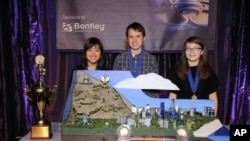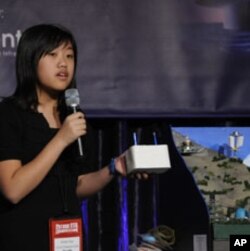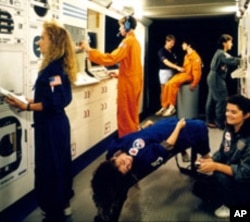On the third and final day of the 2010 Engineers Week Future City Competition regional winners from 39 schools, along with their parents, teachers and mentors packed a Washington, D.C. hotel ballroom for the announcement of the five finalists — whittled down from the 1,100 middle school teams that entered the contest in September.
Each team was given 12 minutes on stage to make their case before the audience and a panel of judges.
System failure
Luke Churchill from North Carolina's Davidson IB Middle School looked confident as he fielded a question about what would happen if the central computer system in his city failed. "We actually have a separate computer system located within a secure facility within the mountain," he told the judges. "So, if the central computer is destroyed or incapacitated in some way the city can continue to function using the computer within the mountain."
It's no wonder that Luke knows his stuff. He and his seven teammates spent nearly every weekend since September on research and design, using computer simulation to turn their ideas into a 3-dimensional table-top model for the contest.
When the judges scores were tallied all that hard work paid off. Davidson won the top award for its future city, called Mamohatra. It means "to revive" in Malagasy, the language spoken in Madagascar.
Team member Ruth Swallow says the fictional town — set in the year 2346 — deals with real-life environmental problems on the island nation today. "We decided we wanted to fix these problems and so our agriculture program doesn't complicate erosion, and also it also replenishes the top soil."
Click to Listen:
Luke adds that the plan incorporates vertical farming, which, he says, "is a process of having different floors and farms within a building. Therefore there is no erosion, and we can more helpfully solve the problems within Madagascar's environment."
Brightest minds
The competition's focus this year was preparing for emergencies. Each team had to design housing for victims of a natural disaster or financial hardship. Davidson met that challenge with a refugee center that had easy access to Mamohatra city services.
Ruth explains that the center's apartment towers are made from an innovative and affordable building material called agro-waste, a compound that combines agricultural by-produces like banana peels and rice husks with beach sand into a kind of stucco. "We pack agro-waste on to a carbon fiber framework equipped with nano sensors. The nano-sensors send electromagnetic waves throughout the brick so that engineers can know when to repair or replace it," she says.
Team member Emily Yue says other buildings in their city integrate a kind of synthetic plastic known as cellulosics. "Cellulosics are basically made from cellulose which is from plants." When mixed with plasticizers, plastic is created, Ruth says. "It's relatively scratch resistant, and it can be molded to form into different shapes. So we used this in most of our buildings."
Emily says these advanced systems — modeled with recycled materials like discarded parts of a fire alarm, cookie containers, shampoo bottles and venetian blinds — are not science fiction. "This city could be built with these technologies in the next 30 years. It's no longer a matter of what things are. It's a matter of how they work, and that's pretty amazing."
Future engineers
And if the Future City Competition is any indication, the team from Davidson IB Middle School will be the engineers doing just that. Luke says he now has an idea of what his future career would be like.
"I realize how much work engineers actually do. Everything in the city, everything in the building, everything in technology has all been created and designed by engineers, and I didn't know how much they were involved in our society."
The next step for this budding engineer and his teammates is a vacation. The Future City Competition grand prize is a trip to Huntsville, Alabama — home to the U.S. Space and Rocket Center's Space Camp — where the students will become astronauts for a week and have a chance to consider the engineering possibilities in space.


















